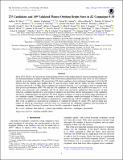275 Candidates and 149 Validated Planets Orbiting Bright Stars in K-2 Campaigns 0-10
Author(s)
Crossfield, Ian
DownloadMayo_2018_AJ_155_136.pdf (6.084Mb)
Terms of use
Metadata
Show full item recordAbstract
Since 2014, NASA's K2 mission has observed large portions of the ecliptic plane in search of transiting planets and has detected hundreds of planet candidates. With observations planned until at least early 2018, K2 will continue to identify more planet candidates. We present here 275 planet candidates observed during Campaigns 0-10 of the K2 mission that are orbiting stars brighter than 13 mag (in Kepler band) and for which we have obtained high-resolution spectra (R = 44,000). These candidates are analyzed using the vespa package in order to calculate their false-positive probabilities (FPP). We find that 149 candidates are validated with an FPP lower than 0.1%, 39 of which were previously only candidates and 56 of which were previously undetected. The processes of data reduction, candidate identification, and statistical validation are described, and the demographics of the candidates and newly validated planets are explored. We show tentative evidence of a gap in the planet radius distribution of our candidate sample. Comparing our sample to the Kepler candidate sample investigated by Fulton et al., we conclude that more planets are required to quantitatively confirm the gap with K2 candidates or validated planets. This work, in addition to increasing the population of validated K2 planets by nearly 50% and providing new targets for follow-up observations, will also serve as a framework for validating candidates from upcoming K2 campaigns and the Transiting Exoplanet Survey Satellite, expected to launch in 2018. ©2018
Date issued
2018-03Department
Massachusetts Institute of Technology. Department of PhysicsJournal
Astronomical Journal
Publisher
American Astronomical Society
Citation
Mayo, Andrew W., et al., "275 Candidates and 149 Validated Planets Orbiting Bright Stars in K-2 Campaigns 0-10." Astronomical Journal 155, 3 (March 2018): no. 136 doi http://dx.doi.org/10.3847/1538-3881/AAADFF ©2018 Author(s)
Version: Final published version
ISSN
1538-3881